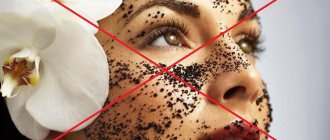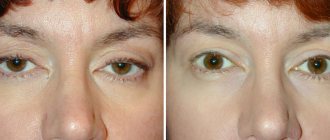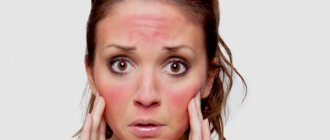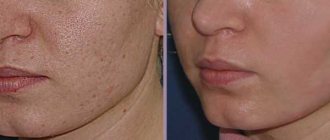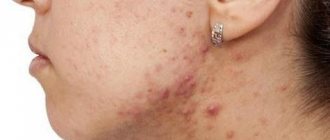You can often tell from a person's face whether he or she has health problems. In this regard, it is very important to follow simple rules and lead a healthy lifestyle to keep your face beautiful and young. However, there are also various kinds of manifestations of pathological changes that are almost impossible to avoid.
Not all people understand what can be done when the skin in the eye area becomes red and begins to peel. In this case, it is very important to understand the root cause of the disease. Below we discuss the main causes of such changes in the skin around the eyes, as well as recommendations for eliminating them.
Traditional recipes for treating peeling skin under the eyes
If the cause of the anomaly does not lie in a serious illness or you simply don’t have time to visit the clinic, try using the gifts of nature and grandma’s recipes.
Some of them are excellent substitutes for medications and successfully fight the disease. However, despite their effectiveness, there is no need to abuse traditional medicine. Before using any recipe, consult your doctor. To prepare a medicinal decoction, no special knowledge or skills are required. Take a tablespoon of herb, pour a glass of boiled water and keep in a closed container until the infusion has cooled. Next, strain it and use it in the following way:
- As lotions. Soak a cotton pad in the liquid and apply to the affected organ of vision for half an hour;
- For washing. Soak a cotton swab well in the solution and wipe the eye in the direction from the nose to the temple;
- For rinsing. Dilute the broth with boiling water in a ratio of 1:5, and irrigate your face with it every time after washing.
If the peeling of the skin under the eyes is caused by not too serious reasons, folk remedies can cope with the unpleasant phenomenon.
To eliminate dryness and flaking, use masks, compresses, lotions and rubbing the skin with ice with the addition of herbs.
Many herbs have miraculous properties that help not only eliminate flaking and dryness, but also tone the skin and give it freshness.
The table shows several recipes for preparing compresses.
| Compress components | How to cook | Effect |
| Chamomile (1 tbsp), water (250 ml). | Steam the dry herb with boiling water and let it brew for half an hour. Keep the compress for 10 minutes, repeat morning and evening. | Relieves peeling, irritation, soothes the skin. |
| Linden flowers (1/2 tbsp), water (250 ml). | Pour boiling water over the flowers and let steep for 1 hour. Strain. Apply a compress to the eyelids for 10 minutes every other day. | Eliminates skin dullness, gives it radiance and elasticity. The skin under the eyes stops peeling. |
| Parsley leaves (2 tbsp.). | Grind the leaves in a blender to release the juice. Blot the discs and apply to the skin of the eyelids for no more than 10 minutes. | Thanks to its rich composition, it actively restores the skin, relieves irritation, and improves blood circulation. |
Due to the fact that 3 quarters of the potato tuber consists of water, potatoes are known not only for their whitening and toning properties for the skin, but also as a means to eliminate dryness and combat peeling under the eyes.
Potatoes contain many vitamins, such as a line of B vitamins, vitamin C, known for its antioxidant properties, vitamin K, selenium and choline.
Vegetables are grated, the juice is squeezed out, and mixed in equal proportions. The lotions are applied for 20-25 minutes; after removal, it is recommended to lubricate the skin with olive or any other vegetable oil.
Read the popular site article:
Clotrimazole ointment, suppositories - instructions for use for women
Peeling of the skin under the eyes can be overcome by regularly making masks from olive or almond oils, which intensively nourish and moisturize the skin.
To do this, you need to moisten gauze or a thick napkin in warm oil and apply it to the skin of the eyelids for 15 minutes. After the mask, wipe the skin with a piece of ice and apply a nourishing cream.
A similar mask can be made from jojoba oil or castor oil.
You can get rid of peeling eyelids using the following folk methods.
You may also be interested in: Zinc ointment for acne - what it is and how it works
Camomile tea
Brew a spoonful of dried chamomile flowers in a cup of boiling water. When the mixture is infused, strain it and moisten cotton pads. Use them as a compress. Also, an infusion diluted with water can be used for rinsing from a pipette. This product helps relieve eye fatigue, eliminate irritation and dry skin. In addition, chamomile has bactericidal and regenerating properties.
Tea brewing
For eye diseases or fatigue, it is useful to make lotions with tea leaves. It is best to use sheet materials, but bags will also work. Both green and black tea are used.
It will also be useful: Types of acne on the face
Aloe juice
To obtain a suitable consistency, you must leave the cut aloe leaf in the refrigerator. In 1-2 weeks the juice will ferment and become more liquid. Use it to lubricate the skin of your eyelids. Aloe is a regenerating, antimicrobial, moisturizing agent, relieves irritation and redness.
Treatment
Treatment of atopic dermatitis begins with systemic pharmacotherapy. Patients are prescribed antihistamines, immunomodulatory agents, membrane-stabilizing drugs, antibiotics and systemic corticosteroids. The main goal of treating atopic dermatitis is to achieve clinical remission, moisturize and soften the skin, and improve the quality of life of patients.
When treating ARVI with antiviral drugs, do not forget about the eyes. To restore the mucous membranes and skin of the eyes, gels based on dexpanthenol are used. When applied topically, the substance is well absorbed and provides faster relief.
To get rid of peeling caused by blepharitis, tear replacement therapy is prescribed. They may prescribe medication in the form of antibacterial ointments and drops.
Sedative medications will help get rid of the formation of scales caused by nervous tension, fatigue or stress. Ophthalmologists recommend taking tincture of oregano and St. John's wort.
To combat an allergic reaction, you will need to protect the patient from the allergen. Antihistamines, antivirals and hormonal drugs are prescribed. In rare cases, antibiotics are used.
Traditional methods
Home remedies can be safely used to treat flaking. Do not use without consultation if dry eyelids are the cause of an internal disease.
Traditional recipes:
- Mix equal amounts of oregano herb and St. John's wort inflorescences. Grind the herbs, pour 10 grams of 200 ml of water, leave for 2 hours. Strain the medicine and take 50 ml at a time. Drink 100 ml per day. Store the remaining remedy in the refrigerator, but it is advisable to prepare a new decoction every day.
- 1 tbsp. l pour celandine with a glass of water. Place the container aside to cool or boil in a water bath. Strain. Soak cotton pads in the solution and apply to closed eyelids for 15 minutes.
- Mash the banana with a fork, add 0.5 tsp. coconut oil. Apply the mixture to the face and décolleté. After 20 minutes, rinse with warm water.
- Parsley juice will help soften the skin of your eyelids. Use only fresh herbs.
Causes of itching
There may be several reasons for this condition. The most common factors that cause itching and redness of the facial skin are dermatological diseases (dermatitis, psoriasis, mild ichthyosis).
Physical reasons
Often the causes of skin irritation can be heat, or vice versa - low temperature, for example, cold wind, high humidity or dry air.
This is due to the fact that the epidermis contains a large number of nerve endings that are sensitive to cold and thermal changes.
Ultraviolet radiation (natural and artificial) with prolonged exposure provokes burns. A person feels as if the skin is on fire, it turns red, and after a while it begins to itch and peel.
Atopic dermatitis
Atopic dermatitis is a manifestation of an allergic reaction.
Its main symptoms are:
- constant itching with redness, which can also appear on the body;
- dryness;
- peeling.
If the rash is scratched, ulcers may form and the face may swell.
Dermatitis is one of the reasons why the face itches. This pathological process can also affect the upper and lower extremities, the torso, however, the most common localization is the eyelids, cheeks and lips.
Mental causes of skin redness
Multiple stresses that often accompany a modern person, emotional instability and a tendency towards depressive disorder can lead to itching, burning and redness on the face.
This is unpleasant not only from a cosmetic point of view. Staying in this state for a long time, a person can undermine his immune system and, thereby, provoke the appearance of eczema and psoriasis.
Psoriasis
Psoriasis is a chronic inflammatory disease. Previously it was believed that psoriasis does not affect the face, but only the limbs, but recent studies have refuted this statement.
The symptoms are:
- itchy redness, as a manifestation of mild inflammation;
- in the worst case, painful, reddened, very itchy plaques;
- peeling.
Most often, psoriasis appears on the forehead, eyebrows and the space between the upper lip and nose.
Vascular diseases
Vegetative-vascular dystonia reduces the tone of skin vessels, which cannot narrow and, as a result, expand. On the chin, cheeks and forehead this manifests itself as redness and itching. All this indicates instability of the nervous system and problems with the autonomic system.
Eczema
Eczema is an inflammatory disease that occurs as a result of exposure to stress and allergic factors. Initially, it manifests itself as irritation on the skin of the face, with the skin constantly itching.
Next, the affected areas turn into blisters, which enlarge and burst over time. Erosion occurs, from which fluid is constantly released. Then scarring occurs, which leads to a cosmetic defect - scars.
Hives
Urticaria is a manifestation of an allergic reaction in the form of a rash that periodically appears and disappears. Acute urticaria occurs as a result of exposure to allergic substances. Redness and itching can occur on any part of the skin, including the face.
You may have a fever and headache. This condition disrupts a person’s sleep for a long time and causes psycho-emotional disorders.
Redness of the skin due to diseases of internal organs
Often problems with internal organs are reflected on the skin.
Some diseases can cause itching and redness on the face:
- Anemic conditions;
- Diabetes;
- Infectious and inflammatory processes;
- Nervous system disorder;
- Kidney diseases;
- Diseases of the gastrointestinal tract.
Seborrhea
When the functional ability of the sebaceous glands is impaired, seborrhea occurs, which is manifested by severe redness and multiple pimples.
Seborrheic dermatitis affects:
- forehead skin;
- eyebrows;
- wings of the nose;
- space above the upper lip.
However, the favorite localization of seborrhea is the scalp.
Non-pathogenic causes
These are reasons that are caused by third-party factors, for example, environmental features or incorrect actions of the patient.
Swimming in reservoirs
This is a common cause of infection by viruses, bacteria and mites. Their activity causes itching in the corners of the eyes, under or on the eyelids. Most often, diseases develop in the summer months, when microscopic algae begin to actively multiply in the water. If they come into contact with the eyes, they cause a number of unpleasant symptoms.
The reaction can also begin when swimming in a pool. Chlorinated water negatively affects the condition of the mucous membranes, causing itching.
Ultraviolet burns
Strong ultraviolet radiation can provoke pain and itching. You can encounter it when visiting a solarium without protective glasses, when watching the sun. A retinal burn can be caused by an electric welding process that uses a powerful light beam.
Blocked tear duct
Burning and itching in the eyes often occurs when the tear ducts are blocked by burning particles or fine dust.
There is an easy way to deal with blockage: just pinch the dots at the inner corners of your eyes for a few seconds. Usually after this, tears begin to flow, clearing the tear ducts. If this does not happen, you should consult a doctor.
Which doctor treats itching?
Pathology is the responsibility of an ophthalmologist (ophthalmologist). He conducts an initial examination and makes a preliminary diagnosis. The patient may need help from doctors of other specialties, such as an allergist, endocrinologist, gastroenterologist and others. In this case, treatment will be prescribed not only to get rid of the symptoms, but also to eliminate the underlying disease.
Causes of peeling eyelids
The most common factors that can be used to explain why the skin on the eyelids peels are:
- allergies or irritation of the epidermis caused by the use of low-quality or expired eye cosmetics;
- seasonal allergies;
- age factor (so-called dry eye syndrome);
- respiratory diseases;
- dry skin;
- hard or chlorinated water;
- contact lenses that were not selected in accordance with all standards, or were stored incorrectly;
- too dry air in the room, where most often there is a person who experiences redness and peeling of the upper eyelid (one or both);
- eye fatigue;
- bad habit of constantly scratching your eyes;
- prolonged sitting at a computer screen;
- using aggressive products to wash or cleanse the skin of the face.
In addition to these factors, peeling and redness of the eyelids can be the result of a foreign object getting into the eyes. In this case, the person will also experience tearing, itching and burning of the eyes. Such irritation of the mucous membrane of the visual organ cannot but affect the condition of the skin of the eyelids.
If the cause of this phenomenon is not associated with serious diseases, then peeling of the skin on the eyelids will go away on its own in a few days. However, if there is any pathology, you should consult a doctor for advice. A thorough examination and modern diagnostic methods will help determine the exact cause of the anomaly.
Pathologies that can lead to peeling of the upper eyelid are:
- Demodicosis, the development of which is caused by hair mites. It can also be diagnosed at home. So, with this disease, the patient experiences redness and flaking on the eyelids, foamy liquid is released from the eyes, and itching and burning are felt. Eyelash loss, increased lacrimation and severe redness of the whites of the eyes are possible.
- Blepharitis. Pathology often develops in people with a weak immune system, as well as with chronic conjunctivitis, vitamin deficiency, and gastrointestinal diseases. Symptoms of the disease can manifest themselves as peeling of the skin of the eyelids, heaviness in the eyes, photophobia, swelling and hyperemia of the eyelids. When the eyelids begin to peel intensely, eyelash loss occurs. There is no need to hesitate: blepharitis is a dangerous disease that can become chronic.
- Conjunctivitis is an eye disease in which there is redness of the whites of the eyes, itching and the presence of purulent discharge. The eyes become swollen and photophobia appears. If the issue of treatment is not addressed in time, the patient’s eyelid skin will begin to peel, not only the upper, but also the lower.
- Barley. This pathology can develop against the background of incompletely cured or often recurrent conjunctivitis. It manifests itself through redness of the eyes and the formation of a lump with pathological contents on the surface of the eyelid (or on its mucous membrane). If the eyelid is peeling, watery eyes and a headache appear, rest assured that your fears are correct – it’s a stye.
- Fungal infections. If the skin on the eyelids is red and peeling, especially in areas where there is hair, the cause of the abnormality may be a yeast fungus. The manifestations of the disease cannot be ignored, as it can be transmitted to others.
- Hormonal imbalance. This pathology can manifest itself in different ways. If, due to an allergy, red spots appear on the eyelids that itch and flake, then with a hormonal imbalance, only the rejection of dead cells of the epidermis is observed. This phenomenon is also not considered normal, but you should not take hormonal medications at your own discretion - leave the choice of medication to a qualified physician so as not to harm yourself.
- Herpes virus infection is another common reason why the skin on the upper eyelid peels. In this case, the epidermis becomes dry and red, and the patient develops blisters on the surface of the eyelids filled with infected fluid. They lead to itching, burning, and painful sensations.
It is extremely rare that the skin on the eyelids peels and itches, indicating the presence of:
- diabetes mellitus type 2;
- liver dysfunction;
- gastrointestinal diseases.
If you cannot independently identify the causes of dry eyelid skin and its peeling, this can only mean that some pathological processes are occurring in the body. The sooner they can be detected, the less dangerous and unpleasant the consequences for human health will be.
Associated symptoms
Itching can manifest itself in different forms. Some patients' eyes itch a little, others experience a strong burning sensation, which is accompanied by pain, discomfort and other characteristic symptoms.
Itching with redness
In almost all cases, itching in the eyes is accompanied by redness of the surface of the whites or eyelids. The appearance of redness can inform the doctor about the presence of an allergic reaction or the development of an ophthalmological disease.
When itching with redness of the cornea, the patient is usually diagnosed with conjunctivitis. The disease is accompanied by increased sensitivity to light, blurred vision, and a feeling of sand in the eyes. The skin around the eyes begins to turn red. Mucous discharge appears on the eyelids, which dries out and remains in the form of crusts.
With allergic conjunctivitis, the mucous membrane turns red and a runny nose may develop. Symptoms occur when allergens enter the body.
Itching with swelling
Swelling around the eyes is a common symptom of an allergic reaction. For example, if itching and swelling are observed frequently and are caused by certain foods, the patient needs to completely reconsider the diet.
Itching with peeling
Peeling of the skin can inform the doctor that the patient has demodicosis. This is a disease in which the sebaceous glands are affected by mites.
The skin turns red around the eyes, around the lips, and on the chin. Symptoms become more pronounced when working at a computer.
Itching in the eyes and ears
If the eyes itch or there is discomfort in the ears, the patient needs to be checked for the presence of microscopic mites.
About 80% of people encounter them. Ticks spend most of their time in passive mode and do not bother humans. Their activity begins when the immune system is weakened and other diseases appear.
Itching with dryness
Dryness of the mucous membrane may indicate dry eye syndrome. It is usually accompanied by itching, burning, fear of light and rapid fatigue of the patient. Sometimes there are crusts in the corner, slight redness of the conjunctiva. The eye begins to hurt.
The feeling of dryness becomes stronger in sunny or windy weather, weakens in humid and warm air.
Itching with runny nose
With a runny nose, redness of the mucous membrane is common. Sometimes there is discharge from the eyes: at first it is transparent, gradually pus is mixed with it. Swelling of the nasal mucosa with dark circles around the eyes indicates the presence of infection.
Itching in the ears, eyes, throat and palate is a symptom of inflammation of the mucous membranes or allergic rhinitis.
Severe itching
Very severe itching in the eyes is caused by various ophthalmological diseases, such as keratoconjunctivitis. It affects the conjunctiva of the eyelid and the eyeball. It is accompanied by hard and dense growths on the eyelids, most often on the upper ones. In addition, photophobia, lacrimation, and viscous discharge may be present.
With pathology of the conjunctiva, the cornea becomes gray and hypertrophied, pain appears due to damage to the epithelium.
Glasses for oval faces
Those with an oval face shape find it easiest to choose glasses. Almost any model will do. Just make sure the glasses you choose don't protrude beyond the contours of your face.
But take into account that square and rectangular frames best highlight the features of an oval face. Oblong, rounded glasses also look amazing
The cat-eye model always looks win-win, and the same, but more voluminous model will definitely not allow you to go unnoticed. It is better to choose larger square glasses, but be careful with them. They are not suitable for everyone.
Diagnostics
Diagnosis of the cause that caused pathological changes in the eyelids and eyes is usually carried out on the basis of external signs. The ophthalmologist examines the patient, asks about concomitant symptoms and previous diseases.
In some cases, it is necessary to conduct a laboratory study of discharge from the eyes, tear fluid; if demodicosis is suspected, the subject of the study is the eyelashes (several pieces from the lower and upper eyelids).
After diagnosis, treatment is prescribed; the principle of therapy is selected individually in each case.
Here are the basic rules:
- Allergies can be treated with antihistamines in the form of tablets or ointments.
- For keratitis and conjunctivitis, antibacterial drops and ointments are used; in severe cases, oral administration is recommended.
- Treatment of demodicosis is carried out comprehensively - the patient is recommended to undergo antiparasitic treatment of the eyelids, take immunomodulators and vitamins, and associated symptoms are eliminated with antihistamines.
- Treatment of stye requires caution. Before ripening, it is not recommended to warm it up at home, but it is permissible to speed up the process with physical procedures. If its size is large or the patient experiences severe discomfort, the stye is opened in the hospital. To speed up healing and prevent the spread of infection, use antibacterial ointments and lotions.
- To eliminate eye fatigue, special moisturizing drops, vitamins, and eye exercises are prescribed.
The duration of treatment, list of medications and dosage are selected individually.
Medicines
Treatment of many eye diseases is carried out comprehensively and is prescribed by a doctor, based on the severity of the disease, age and health of the patient. The list of medications varies in each specific case. The most available drugs:
- Antibiotics are drugs of synthetic and biological origin with an antimicrobial effect.
Okomistin, Levomycytin, Albucid, Torbex, Tsipromed are prescribed in the form of drops. When the mucous membranes and membrane of the eyeball are affected, it is more effective to use ointments: tetracycline, Torbex.
- Antiseptics to prevent the spread of infections.
For eye diseases, use the most gentle, non-irritating mucous agents: Vitabact, boric acid solution or preparations with silver.
- Antihistamines are drugs to relieve itching and swelling.
These can be traditional Claritin, Loratidine tablets or topical preparations: Alergodil drops, Opatonol, hormonal ointments with hydrocortisone or dexamethasone.
- Antiviral agents: Anaferon, Acyclovir (ointment), Solcoseryl.
- Antifungal drugs: Levorin, Nystatin.
- Anti-inflammatory drugs are used if eye damage and peeling are non-infectious: Dexamethasone drops, Sofradex, Maxitrol.
- Vasoconstrictor drops, for example, the well-known Visine, help eliminate eye fatigue.
To increase the body's resistance to infections, immunostimulants (Echinacea tincture, Ergoferon) and vitamin complexes are prescribed. In the treatment of eye diseases, biological supplements with blueberries and eye vitamins are effective: Vitrum Vision, Complivit Oftalmo.
To eliminate the cause of peeling eyes, local remedies are usually used: drops and ointments. Such drugs act directly on the pathogen and practically do not penetrate into the blood.
If treatment involves the use of several types of drops, they are applied at intervals of at least 15 minutes. Ointments intended to act on the eyeball are usually placed under the eyelid at night.
Traditional therapy
You can get rid of peeling eyelids and other signs of eye disease using alternative medicine. They can be used if a symptom occurs as a result of allergies, fatigue, dry air, or as an auxiliary method in the treatment of serious diseases (usually after recovery).
To moisturize the skin, you need to wash your face with boiled, melt water, herbal decoctions or natural tar soap. The latter has unique properties: along with a pronounced antibacterial effect, it softens and moisturizes the skin.
Herbal decoctions can be used for rinsing and lotions. To prepare healing liquids, chamomile, St. John's wort, calendula, string, and celandine are used. The last two are used if it is necessary to eliminate the inflammatory process. They are not suitable for healing or dry skin, as they are very drying. Celandine is a poisonous plant, so you must be careful when using it.
The preparation of the medicine is very simple: a tablespoon of any herb (or a mixture of several) is poured with a glass of boiling water and kept in a closed container until it cools or boiled in a water bath for 5-10 minutes. The liquid is filtered through thick cloth and used:
- As lotions (compresses). Cotton pads or a piece of cloth are moistened in liquid and applied to closed eyelids for 15-30 minutes.
- For washing eyes. Moisten a cotton pad generously and wipe the eye from the nose to the temple. If both eyes are affected, use separate discs.
- For rinsing the face after washing. The infusion is diluted with boiled water (1 to 5) and irrigated on the face.
For the same purposes, you can use black tea, preferably large leaf tea without additives. It is necessary to prepare a very strong brew and use it as described above.
Softening masks made from available products will help eliminate peeling.
Recipe one:
- grate raw large carrots on a fine grater;
- add the yolk of a chicken egg to the vegetable mass, mix;
- add 1.5-2 tablespoons of flour to the mixture and beat well;
- apply the mixture in a thick layer to the eyelid;
- leave for 20 minutes and rinse.
Recipe two:
- mash a ripe banana with a fork;
- melt 2 tablespoons of honey and the same amount of butter in a water bath;
- connect all components;
- Apply on eyelids and wash off after a quarter of an hour.
Recipe three:
- Boil large potatoes in their skins, cool and mash;
- soak a piece of white bread in cream;
- connect both components;
- Apply on eyelid for 20 minutes.
Fresh parsley juice, a mixture of carrot and apple juice, cosmetic oils (cocoa, peach, wheat germ, shea) or regular olive oil will soften delicate skin.
During treatment, you need to pay great attention to hygiene procedures, stop wearing contact lenses and follow all the doctor’s recommendations.
Treatment with drugs
Therapy is selected for each patient individually after identifying the factor that triggered the development of the disease
It is important to treat not the manifestation of the disease, but its source. Otherwise, any measures will not bring results.
Most often, medications are the first to hit the target. The doctor may prescribe the following medications:
- Antibiotics. The most commonly prescribed eye drops are Okomistin, Albucid and Tsipromed. For damage to the mucous membrane, tetracycline ointment is used;
- Antiallergic and antihistamine medications. Helps get rid of itching and relieve swelling. This could be Claritin, Loratidine, or hormonal ointments that contain hydrocortisone;
- Antiseptic drugs. Block the spread of pathogenic microorganisms. Use the most gentle means, such as “Vitabakt” or a solution of boric acid;
- To combat the fungus, Levorin or Nystatin is prescribed;
- Antiviral drugs. These include “Anaferon”, “Solcoseryl”;
- If the cause of peeling lies in inflammation, then Sofradex or Maxitrol eye drops will help;
- To relieve visual fatigue, doctors recommend taking Visine.
To strengthen the immune system and increase the body's resistance to negative factors, take a course of Vitrum Vision or Complivit Oftalmo vitamins.
| Often, to get rid of unpleasant symptoms, doctors prescribe topical medications (ointments and drops). They affect the source of the disease and almost never enter the circulatory system. If you need to use several types of drops, use them with a break of fifteen minutes. |
Methods of treatment and elimination
Redness can be eliminated in different ways depending on the cause - from cosmetic camouflage to complex antibacterial treatment.
If the issue is an allergy (seasonal or to a specific substance), the allergen or a group of them is first identified.
Note! After exclusion or maximum limitation of allergens, the patient is prescribed a course of antihistamines.
These can be tablets (loratadine) or eye drops (okumetil, allergodil, cromohexal).
If bacterial ophthalmological or dermatological pathologies manifest themselves in this way , appropriate therapy is required .
For conjunctivitis, drops of ciprofloxacin, sodium sulfacyl, chloramphenicol, and albucid can be prescribed.
If the causative agent is a virus , actipol, ophthalmoferon or their analogues are used. In difficult cases, it is possible to combine several groups of drugs and add steroid, immunomodulatory and antihistamine drugs.
Blepharitis is treated not only with antibacterial drops , but also by applying ointments containing an antibiotic (tetracycline, gentamicin ointments).
Another ophthalmological disease that affects the outer part of the eyelid is stye.
This disease in most cases does not require special separate treatment.
Folk remedies
First of all, it is worth remembering that folk remedies help reduce symptoms. It is unacceptable to use them as a separate treatment. A parsley compress will soothe irritated eyes.
To do this, you need to place fresh grass in gauze (it is better not to cut it, but to tear it with your hands) and apply it to the skin. Such lotions are good for removing dark circles under the eyes.
A decoction of chamomile or dill seeds will help with reddened skin. The grains are placed in cheesecloth and then in hot water. Chamomile ice will soothe the eyes and itching. To do this you need to pour 1 tbsp. plants with a glass of boiling water, and strain after half an hour.
Then the solution is sent to ice trays. When the product is ready, you can use it to wipe the irritated eyes several times a day. Chamomile ice relieves not only inflammation of the visual organ, but also redness and itching of the skin.
Chamomile decoction is a universal eye antiseptic.
A decoction of dill will relieve swelling and soothe the irritated surface of the face. It is necessary to soak a cotton swab in the broth and place it on the eyelids. After it cools down a little, repeat the procedure. Using the same scheme, an infusion of cornflower is prepared (a glass of the plant per 2 tsp).
For skin diseases, a potato mask is suitable. The raw vegetable must be peeled and chopped using a grater, adding 1 tsp. olive oil.
Then you need to place the paste on several pieces of gauze and roll it up and apply it to the irritated eyes. After 10 minutes, the mask is removed by rinsing the skin with cool water or the decoctions described above.
Homemade masks made from cucumber or raw potatoes are good for swelling
Prevention
If your eyelids dry out, you can reduce the occurrence of the symptom in the future by adhering to the simple rules established by ophthalmologists:
- using high-quality cosmetics (even if they are a little more expensive, natural-based, but there will be no need to look for the cause and treat allergies);
- do not touch your eyes or other parts of your face with dirty hands (this is the cause of infections, inflammation and rashes);
- Use creams, wash gels and lotions in accordance with your skin type;
- if you are prone to peeling due to weather conditions, wipe your eyes every morning with chamomile decoction (can be frozen, ice tones);
- use vegetables and fruits instead of store-bought masks (they decided to eat an apple - they applied the halves to their eyelids, cucumbers are especially useful - they moisturize, tone, relieve fatigue).
Why does the skin around the eyes peel?
Peeling of the skin under the eyes has various causes, and one of the most popular is improper or irregular care, but it can also be due to health problems. In most cases, when the skin around the eyes peels, people turn to ophthalmologists, who carry out diagnostics or immediately refer the patient to another specialist.
The reason why the skin on the face near the eyes peels may be due to an allergic reaction. By contacting an allergist and starting antihistamine therapy, you will be able to get rid of the disorder as soon as possible.
When the skin around the eye peels and redness occurs, eyelash mites cannot be ruled out. It is able to exist on healthy skin without obvious lesions. To detect a violation, special hardware diagnostics are required.
The skin around the eyes in men and women may begin to peel due to a lack of vitamins in the body. In this regard, it is necessary to constantly monitor your diet, as sometimes the problem is provoked by fatty foods. In addition, itching and dryness occur as a result of insufficient fluid intake. Read more about what vitamins are needed for dry skin in a separate article.
Such subtle reasons as:
- insufficient sleep;
- constant stress;
- dirty environment;
- climate (strong wind, frost, strong sun).
Dry skin under the eyes of a child can have quite different causes, but the most common among them are demodicosis, various infections and bacteria (staphylococcus). To treat redness, dryness and peeling in the eye area in children, it is better to consult a doctor immediately.
We figured out why the skin under the eyes peels, and now let’s look at ways to combat the disorder.
Treatment for itchy eyes
If itching occurs, you can apply cold or warm compresses. They soften hard crusts on the eyelids and reduce the appearance of swelling. You can only touch your eyes with pre-washed hands!
The doctor selects special drops and ointments to eliminate itching and other symptoms. They moisturize the mucous membrane, reduce its irritation and inflammation. The ointments may contain a broad-spectrum antibiotic that is effective in fighting infection. It relieves inflammation and irritation. Eye drops, such as Gilan, work well.
If the discomfort is caused by a systemic disease, the doctor determines how to get rid of itchy eyes with the help of drug therapy and prescribes medications to relieve symptoms.
Eye drops
A good choice is eye drops that are aimed at getting rid of the main signs of ophthalmic diseases.
Drops are suitable for the treatment of acute and chronic inflammation, prevention of eye diseases. They relieve irritation, eliminate itching and redness. May have antiallergic and anti-inflammatory effects. They are often used to improve the condition of the eyes after injuries, surgery, and infectious pathologies.
Pay attention to Gilan drops. They contain hyaluronic acid, which has a long-lasting, pronounced moisturizing effect. It facilitates the patient’s condition when he frequently spends time behind a monitor screen or while driving. The drug can be used by children and pregnant women.
The use of antibiotics is permissible only after a doctor’s prescription! Long-term uncontrolled use of the compounds can lead to lens clouding, glaucoma or dry eye syndrome. Before starting treatment, it is necessary to find out why the eye itches.
How to eliminate itching yourself?
First of all, you should determine why the skin around the eyes and eyelids constantly itch. If the cause is not related to serious illnesses, you can use home treatment methods.
What is recommended to do if there is severe itching in the eyes?
First, give your eyes a rest. To do this, you need to remove your lenses or glasses, wash off your makeup, and turn off your computer and TV. You can cover your eyelids with your palms for a few minutes and look at a distant point. If your eyes are very itchy, it is advisable to rinse them with boiled water or saline solution, strong tea or a decoction of medicinal herbs. It is better to keep drops on hand to moisturize the mucous membranes, which can be bought at any pharmacy. If the itching is caused by allergies, antihistamines will help relieve the condition. To speed up the process, you can use eye drops that moisturize the mucous membrane and relieve irritation.
A few simple exercises
- If you feel tired, close your eyes tightly for 3 seconds.
- Blink frequently for 30 seconds.
- Roll your eyes in a circle for 20 seconds.
- Close your eyes and cover them tightly with your palms for 5 seconds.
How to deal with swelling?
If you find such unpleasant consequences, you can simply wait until they are eliminated on your own - it will take a few days and they will pass.
This problem may go away after a few days.
The second way is to seek advice from a cosmetologist who performs the procedure. Most likely, he will recommend actions to speed up rehabilitation.
How to get rid of peeling eyelid skin
Any eye disease, even minor, requires proper treatment. Such a seemingly harmless symptom as peeling on the eyelids should not be ignored.
If, apart from dry eyelids, there are no other symptoms (pain, photophobia), or there is no opportunity to get to an ophthalmologist, you can try to alleviate the condition yourself:
- Provide rest to your eyes - limit watching TV, do not use the computer. Wear sunglasses when going out into the sun.
- Apply brewed and squeezed tea bags to your eyes, make compresses with natural rose water and herbal infusions.
- Do not use decorative cosmetics.
- Do not eat possible allergens.
- Relax and get a good night's sleep.
- Do not use contact lenses
If the cause of peeling of the eyelids is minor (overwork, allergies to cosmetics), your health will improve after eliminating the irritant, and after a few days the skin condition will normalize.
If peeling is accompanied by severe pain and unresponsiveness to bright light, a visit to the ophthalmologist cannot be postponed.

